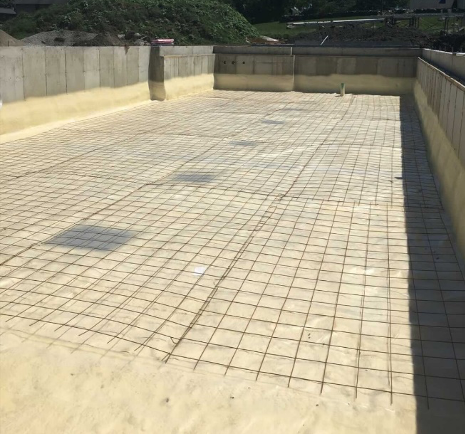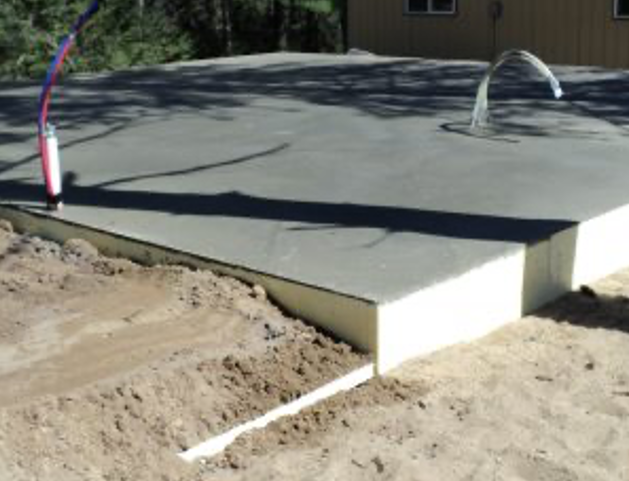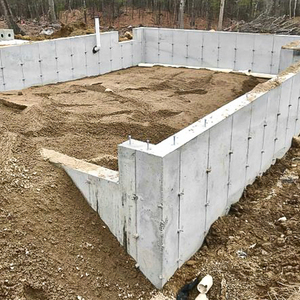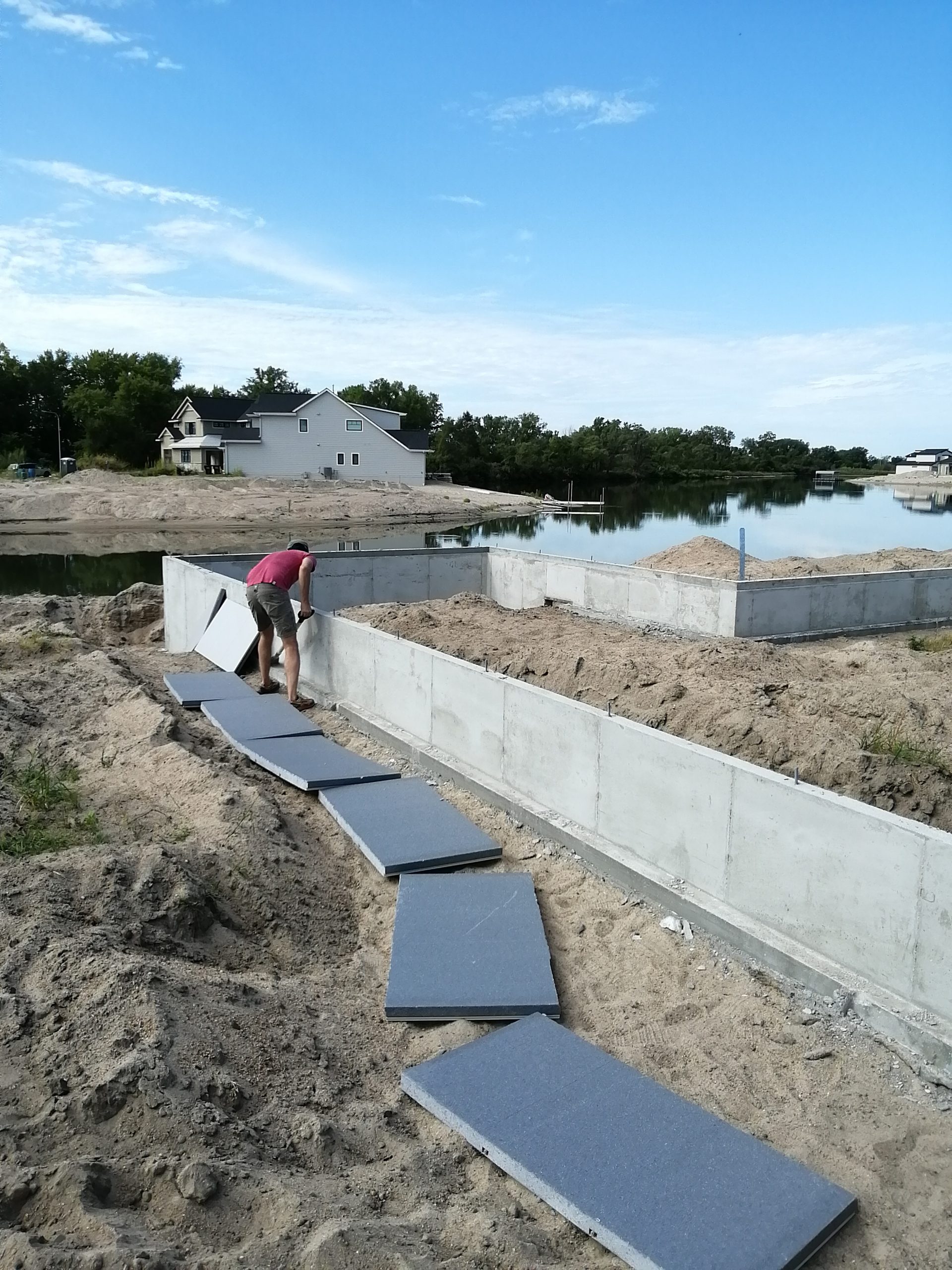
A few years ago, New England contractor Wade Paquin of WKP Construction introduced me to the technique of using closed-cell spray foam (CCSF) below a slab. He was insulating the below-grade slabs of the new homes he was building by spraying a couple inches of CCSF over a gravel bed before pouring the concrete. I have since had the opportunity to try this insulation method on a few of my own projects. I’ve concluded there are benefits to this approach.
Standard regional practices
Frost-protected slab-on-grade construction has been common in my market for several years. I collaborated with my concrete contractor to design an insulation system for a frost-protected shallow foundation (FPSF) that we used on several projects. I have not had any call-backs, so I assume everything is working as designed. The drawback is the amount of time it takes to do a good job installing the insulation and then detailing the polyethylene sheeting used for air, vapor, and radon control. It can take multiple days, especially on larger projects.

The photo to the right shows a small guest house I built in 2011. The project took two days to install and seal the sub-slab insulation. There are 2 in. of XPS foam under the slab and footings, 2 in. covering the slab edge—cast in place during the concrete pour—and 4 ft. of 2-in. XPS used as a wing for the perimeter foundation insulation. (See the IRC Table R403.3(1) for local requirements).
An inherent problem
With blower-door testing, I have determined that penetrations in slabs are a source of air leakage. I believe the air is coming down the radon pipe on the roof, entering the radon rock bed, and finding a path either along a pipe, a cast-in-place tub box, or other floor penetration. Often the…
Weekly Newsletter
Get building science and energy efficiency advice, plus special offers, in your inbox.

This article is only available to GBA Prime Members
Sign up for a free trial and get instant access to this article as well as GBA’s complete library of premium articles and construction details.
Start Free TrialAlready a member? Log in















23 Comments
It sounds like you are indicating that the high-global-warming potential foams are special order and the HFO-blown foams are now standard? That's good news if true. Of course one should specify the HFO-blown low GWP foam to be sure.
It's worth noting that the overall climate impact of spray foam is still higher than most others, even with low GWP blowing agents, because of the polymer content.
I'm not sure if the spray foam contractor was talking about his orders or everyone in the insulation business, it could be when he places an order for foam sets, it's an automatic for him to get the the HFO foams, but he did make it sound like it is the norm. Maybe any other spray foam contractors could chime in.
Thanks for the additional context there. That's encouraging. As for hearing from more spray-foam contractors, I'm not sure there are many who hang out on GBA, but if there are any it would be interesting to hear from them.
What I've been seeing is that many states have banned HFCs, which means that HFO ccSPF is the only legal/sellable option. Here's what the listing is:
https://www.hfcbans.com/bans-by-region.html
However, what I have heard from the field is that in non-HFC-ban states, where you can still legally get HFC foam, it is *difficult* to get HFO foam. Basically, the manufacturers have limited manufacturing capacity, so they're shipping all of their HFO foam to the states that legally require it.
I wonder about the relationship between the spray foam and slab above.
- Given that you are going to want to ensure that the slab is at least the specified thickness at its thinnest point, you are inevitably going to have to use more concrete to compensate for the uneven foam substrate than you would if poured over flat foam boards.
- Related to that is how you would ensure that reinforcing was placed at the correct depth given that the depth varies.
- Concrete moves seasonally. Is locking it into a lumpy substrate a good idea?
- We can rely on the specified load capacity of foam boards, but have no way of guaranteeing what that is for site sprayed foam.
Hi Malcolm,
I originally learned about sub-slab insulation from Wade Paquin at WKP Construction, he's been using sub-slab CCSF for nearly a decade with no issues. My first project so far has been a success. You are right about estimating concrete quantities, the Barndominium project called for 135 yards of concrete, I think they needed a little more and had to order a partial truck to finish. The concrete crew was aware they may be short going into the pour. As far as concrete reinforcing, a good crew should be able to get the bar or mesh in the right location, I've seen some crews leave the bar or mesh at the bottom while pouring, regardless of the sub-slab insulation. Same as all trades, some do great work, some work the way they were taught and maybe don't know the difference. Some don't care. As far as load capacity, the spray foam was specified to a specific density by the company that did the engineering. The insulation contractor is a good friend, I know he wouldn't supply us with something different than what was expected. My understanding is that you can get CCSF at higher densities, much like XPS or EPS if needed. I was able to walk the foam after it was installed, it actually seemed more dense than the XPS I've used in the past, it just may have felt that way because of being a monolithic product with no seams to lift or move. Using CCSF sub-slab isn't for every project, I am happy with the two I've been involved with. Thanks for the comments.
Randy,
Thanks for replying, and thanks for the very informative article. Anything new always raises questions, and it's good to hear my concerns may not be that important.
Malcolm, I appreciate you and other readers questioning a new or uncommon building practice, or even disagree with something I've written. I've had several discussions on Instagram about using CCSF, not only below grade, but anywhere in a build. Some comments were very clear about how the reader feels towards any use of CCSF. We try to think of everything that could go wrong with an assembly or technique, but there's no way one person can come up with every scenario. Communicating with others on a platform like Green Building Advisor has helped develop many of the decisions I use in builds I'm involved with. Thanks again for the comment!
I'm skeptical about the low GWP of the newer foam - what are the numbers? Given that CCSF is the highest GWF of the commonly used foams, it would need to be reduced a lot to be even close. EPS, on the other hand, is the most common, least expensive under slab foam with the lowest GWF, and in my mind, worth spending a little time to get right.
On the larger question, CCSF is the only thing you can easily use on uneven floors commonly found in very old homes, and it's faily common here in the Northeast for that use.
I don't understand Malcom's comments that "concrete moves seasonally". Where and why would it move if the substrate is at a constant temperature?
Bob,
You are right - I wasn't thinking. If the slab is isolated from swings in temperature and humidity it will remain stable. Any problems due to an uneven substrate should only occur during the initial cure, or if the building was left unheated.
Thanks Malcolm!
Thanks back at you Bob. I always find your posts insightful and useful.
For what it's worth, Brian Just's column from earlier this year provided numbers:
Choosing Low-Carbon Insulation
Make informed selections based on more than R-value
https://www.greenbuildingadvisor.com/article/choosing-low-carbon-insulation
GWP of closed-cell spray polyurethane foam with HFC blowing agent is 14.86 kg CO2e per 1 m2 of RSI-1 worth of material
And 4.00 kg CO2e per 1 m2 of RSI-1 for HFO spray foam. And EPS at 3.49.
Ccsf can be quite brittle and course and I doubt manufacturers approve this buried Su slab use.
Hi Doug, The manufacturer used in the "barndominium" project does approve the use of CCSF under slab. Here's a link to their approval letter.
https://www.carlislesfi.com/wp-content/uploads/LTR-SPF-Under-Slab.pdf
I had the same question.
I have been considering this approach. One benefit not mentioned here is that the spray foam fills the voids between the stone. Ridged foam is supported only at the tips of stone. Therefore it seems to me that a spray foam product offers better bearing capacity when compared to sheet product of the same density.
I am however concerned that lumpy foam could create weak spots in the slab, (which means thicker concrete slab would be required).
As for getting reinforcing at the proper level within the slab, stainless steel fibers in the concrete mix are well distributed in the entire mix and might be better than wire mesh.
Hi Randy,
I'm down in the twin cities and would be interested to know who your SPF installer was.
Hi Jon, We used Polar Insulating, email me and I'll get you their contact info. [email protected]
We apply foam and have had good luck with this approach. We have used it as well on the outside walls of old rubble, stone foundations that are being dug up.
The issue we have run into and why I have not promoted this in my area is spray foam needs specific conditions to do it right. Namely, the substrate must be bone dry and at the very least, above 40 degrees. These requirements can hold up a job if there is a few days of rain, even mist in the forecast, or the temperatures drop.
In my case, we are usually booked out for months, and having to reshuffle the schedule if the conditions are not just right was proved too difficult.
Older thread but I’d like to see if anyone has opinions on this option is relation to maintaining a good waterproof layer below the slab. We are about to build a full basement house in Victoria and my main concern is proper detailing to maintain a dry basement. Robust Perimeter drains, good waterproofing on the foundation walls with dimple mat and exterior sump pumps. Just don’t want to detail a basement that will have issues. Cost is second to a dry basement for the life of the building.
Thanks for any input!
Onesmallstep,
To me the most important sub-slab elements to include for water management are a layer of freely draining gravel to act as a capillary break, and a good vapour-barrier. I don't think much rides on what type of insulation you use.
Thanks Malcolm,
Personal build in a wet climate, full basement with 10’ of clay the whole way and no gravity drain parameter drains, pumped up to city, so I’m leaning on the paranoid side of detailing the basement. 😬 I totally agree with you and likely just over thinking it. We will get a good clear crush layer all around. I guess I just wonder how the Closed Cell spray foam will act as a Vapour Barrier below the slab over many years in relation to water ingress management. Ie shrinkage and potential separation at places. Have opened up “older” homes with spray foam and have seen it separated from framing in places.
onesmallstep,
In terms of vapour driven moisture, I think you are all set with the capillary break, and poly. If you get water building up under the slab, I'm not sure there is much that can resist the hydraulic pressure.
I'm typically an anti-basement guy, due to having seen how many experience flooding at some point. But having said that, considering our wet climate on the South Island, basements generally do relatively well here for some reason.
One thing you might consider is moving your sump pit outside into the yard. That makes the replacement of equipment, or emergency pumping a lot easier.
Log in or become a member to post a comment.
Sign up Log in